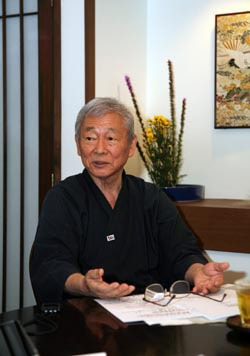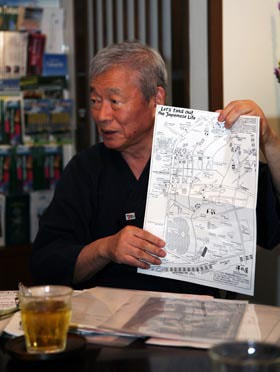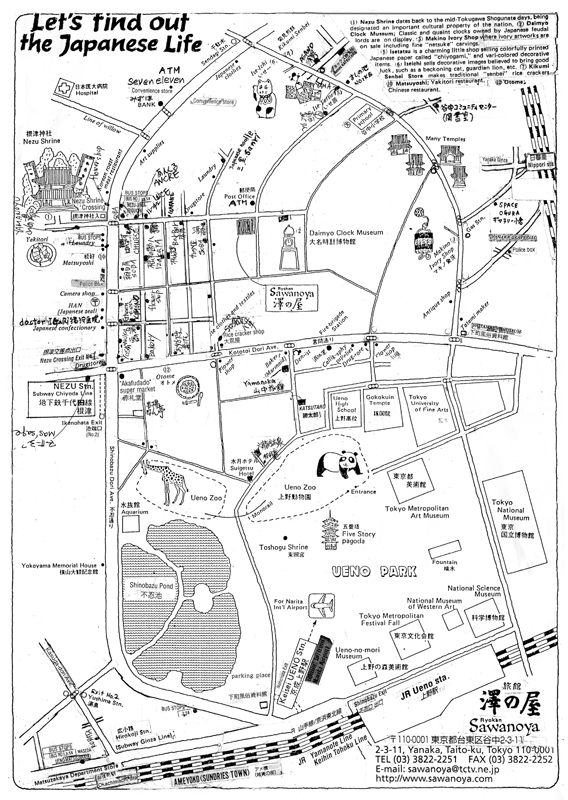
Isao Sawa, the landlord of Ryokan Sawanoya
Sawa got married to only daughter of Sawanoya. He took over his wife's family business, that is Sawanoya, after leaving Tokyo Sogo Bank (at that time). As a travel advisor he has also eagerly given talks throughout the nation, and delivered lectures or held consultations at universities and research institutes.
Ryokan Sawanoya opened in 1949 in Yanaka. Later, Sawanoya was enlarged to have 24 rooms in its 3-story building because the Tokyo Olympic Games was held and the number of school excursion groups increased. However, the number of guests decreased significantly after the Japan World Exposition held in 1970. Moreover, the Metropolitan Electric Railway running along Shinobazu Street was abolished, so there was no transportation from Ueno to Yanaka. Also, since budget hotels opened one after another in the Ueno Station area, it became difficult to run inns in the Yanaka area. In 1982, the landlord of "Yajima Ryokan" in Shinj commodated 230 guests in 1982, the first year. Then, the number of guests have steadily increased, and, to date, a total of more than 150,000 guests have stayed at Sawanoya. When he started to manage Sawanoya, he always thought about expanding the scale of operation. However, he became to know about B&B (Bed and Breakfast) accommodations from conversations with foreign travelers and his own overseas experience, and thought that appropriately-sized Japanese inns, where guests can become acquainted with Japanese cultures and customs, are also important, other than expanding the scale of operation. The number of guests decreased
*Japanese Inn Group
A group of inns that intend to contribute to international goodwill in the area of private-sector diplomacy with the aim of attracting foreign tourists
Q: Sawanoya have accommodated many guests from abroad. What kind of guests are there?
Sawa: Although Japan has eagerly tried to promote tourism and attract overseas tourists, most of the tourists are group tourists from Asian countries, who make use of large travel agencies. Last year, 92% of our guests were from the United Sates, Oceania and Europe, and 6% were from Asia. Most of them were independent travelers who did not use travel agencies.
11 countries out of major 20 countries that have the largest number of travelers who have visited Japan are Asian countries. A total of 6 million travelers come to Japan each year from those 11 countries. On the other hand, 1.8 million travelers come from other 9 countries, including America and European and Oceanian countries. Most of them stay in Japan for a long time, and travel around the country. Although it is said that prices are high in Japan, in fact, things are not so expensive. If travelers purchase Japan Rail Pass and have inexpensive lunches, they can travel economically. Although I hesitated to accept foreign travelers because I could not speak English, I realized that, after actually accepting them, any inns and hotels can manage to serve non-Japanese guests if they can write Roman letters and have some dictionaries.
*Foreign Individual Tourist : Independent Travelers
Q: How many regular guests do you have? How do they reserve rooms?
About 30% of our guests are regular guests. At first, they made reservations by letter, and then, by fax. Nowadays, they make reservations by e-mail and phone. Some regular guests stay at Sawanoya for the first time in three to five years. They visited Japan when they were young, and later, they come to Japan with their families after getting married and having children. In this way, they make links with Japan, and come back to Japan. They usually say that, although Japanese inns and hotels politely do what they do not ask, Sawanoya heartily do what they ask, so they like such hospitality of Sawanoya.
Q: Do group tourists and tourists from Asian countries stay at Sawanoya?
We do not accept any group tourists who use major travel agencies. Some Asians who visit nearby universities, including the University of Tokyo, also stay at Sawanoya through the introduction of the universities. We accept tourists from any countries.
We participated in the Japanese Inn Group 32 years ago in 1980. At that time, guests could stay at Sawanoya for 7,500 yen per night, a room charge was 4,100 yen (now, it is 4,800 yen), and a dinner and a breakfast were 2,500 yen and 900 yen, respectively. However, the number of guests who have dinner had decreased because a dinner was expensive compared to a room charge or some guests did not have dinner for religious reasons. Therefore, we stopped preparing dinner. Instead, we have created a map of the Yanaka area in order to tell guests which restaurants can serve meals that suit their tastes. At first, we provided English-only maps, but those maps were not popular with our guests. Since Japanese names were not written on the map, when they visited stores, they could not tell whether English names on the map corresponded to actual store names. Therefore, I consulted with Mr. Okada at "Shalom Insatsu," a printing company, which has printed pamphlets of the Japanese Inn Group, and then walked with him around towns time after time, and created a map through which our guests can understand Japanese lifestyles and cultures. (continued in the upper right column)

We asked owners of stores, which are introduced on the map, to display "Welcome to" on store signs and to make English menus. At first, those owners became slightly disoriented, but, if English menus with pictures and prices were prepared, foreign travelers could grasp images of meals, so they accepted the idea. We were also suggested from guests that we should put names of good and cheap restaurants or information about nearby national museums on the map. We thought that a location of the Yanaka area is not good because it is far from Ueno Station, but that perception has changed. (continued in the lower column)
The map of the Yanaka area
Detailed information about Yanaka, national museums in Ueno Park, Ueno Station and the transportation guide from Uguisudani Station are written on the map.

Also, locations of banks, post offices, hospitals, drugstores, cleaners, barbers, convenience stores, public baths, antique stores and restaurants, which are important information for long-stay guests, are on the map. A phrase "Let's find out the Japanese Life" is written on the map, and locations of "Nezu Shrine," "Daimyo-dokei Hakubutsu-kan," "Makino Zoge-ten," "Isetatsu," "Iseichi" and "Kikumi Senbei" are also on the map. Yanaka is not a tourist spot but a living area, so a guidebook and a map which introduce our daily lives are important. When visitors check in Sawanoya, we hand over this map, English subway map and map of all areas of Tokyo that is created by the Tokyo metropolitan government. Event sites are also put on the map during festival seasons. Three young artists from France wanted to stay in a larger room with bath and toilet. After a while, however, they had an interest in this town, and stayed at Sawanoya for three months.(continued in the next page)

Isao Sawa, the landlord of Ryokan Sawanoya
Sawa got married to only daughter of Sawanoya. He took over his wife's family business, that is Sawanoya, after leaving Tokyo Sogo Bank (at that time). As a travel advisor he has also eagerly given talks throughout the nation, and delivered lectures or held consultations at universities and research institutes.









